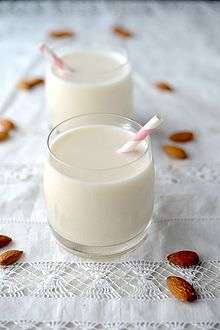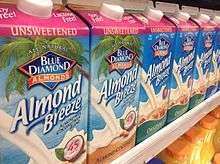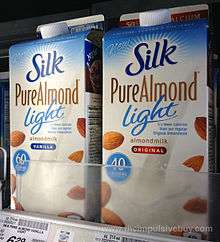Almond milk

Almond milk is a plant milk with a creamy texture and nutty taste. It contains neither cholesterol nor lactose, and is often consumed by the lactose-intolerant and others who wish to avoid dairy products, including vegans. Commercial almond milk comes in sweetened, unsweetened, plain, vanilla and chocolate flavors, and is usually enriched with vitamins. It can also be made at home using a blender, almonds and water.[1]
It is traditionally consumed through much of the Mediterranean. Within the Italian regions of Sicilia, Puglia, Calabria, Campania it is a protected traditional agricultural product.[2]
Sales of almond milk overtook soy milk in the United States in 2013,[3] and by May 2014 it comprised two-thirds of the US plant-milk market.[4] In the United Kingdom, almond milk sales increased from 36 million liters in 2011 to 92 million in 2013.[3]
History
In the Middle Ages, almond milk was known in both the Islamic world and Christendom. As a nut (the "fruit of a plant"), it is suitable for consumption during Lent. Almond milk was a staple of medieval kitchens because cow's milk could not keep for long without spoiling.[5]
Sales
In the United States, almond milk remained a fairly niche health food item until the early 2000s, when its popularity began to increase. In 2011 alone, almond milk sales increased by 79%.[6] In 2013, it surpassed soy milk as the most popular plant-based milk in the U.S.[7] As of 2014 it comprised 60 percent of plant-milk sales and 4.1 percent of total milk sales in the US.[8]:2–3
Popular brands of almond milk include Blue Diamond's Almond Breeze and WhiteWave Foods' Silk PureAlmond.[7]
Nutrition
| Nutritional content of cows', soy and almond milk | |||
|---|---|---|---|
| Cows' milk (whole, vitamin D added)[9] | Soy milk (unsweetened; calcium, vitamins A and D added)[10] | Almond milk (unsweetened)[11] | |
| Calories (cup, 243 g) | 149 | 80 | 40 |
| Protein (g) | 7.69 | 6.95 | 1 |
| Fat (g) | 7.93 | 3.91 | 2.5 |
| Saturated fat (g) | 4.55 | 0.5 | 0 |
| Carbohydrate (g) | 11.71 | 4.23 | 2 |
| Fibre (g) | 0 | 1.2 | 1 |
| Sugars (g) | 12.32 | 1 | 0 |
| Calcium (mg) | 276 | 301 | 450 |
| Potassium (mg) | 322 | 292 | 170 |
| Sodium (mg) | 105 | 90 | 180 |
| Vitamin B12 (µg) | 1.10 | 2.70 | n/a |
| Vitamin A (IU) | 395 | 503 | n/a |
| Vitamin D (IU) | 124 | 119 | n/a |
| Cholesterol (mg) | 24 | 0 | 0 |
If unfortified, almond milk has less vitamin D than fortified cow's milk; in North America cow's milk must be fortified with vitamin D, but vitamins are added to plant milks on a voluntary basis.[12] Because of its low protein content, almond milk is not a suitable replacement for breast milk, cow's milk, or hydrolyzed formulas for children under two years of age.[13]
Production
The basic method of modern domestic almond milk production is to grind almonds in a blender with water, then strain out the almond pulp (flesh) with a strainer or cheesecloth. Almond milk can also be made by adding water to almond butter.
References
- ↑ Larmer, Christina (2011-01-09). "The pros and cons of almond milk". Adelaide Now.
- ↑ "Guida ai Prodotti Tipici del Territorio di Brindisi" (PDF).
- 1 2 Rebecca Burn-Callander, "How the UK is going crazy for almond milk", The Daily Telegraph, 17 November 2014.
- ↑ Tom Philpott, "Lay Off the Almond Milk, You Ignorant Hipsters", Mother Jones, 16 July 2014.
- ↑ Bynum, W.C. (1988), Holy Feast and Holy Fast: The Religious Significance of Food to Medieval Women, University of California Press, p. 41, ISBN 978-0-520-06329-7
- ↑ David Sprinkle (2012-01-19). "With Almond as the New White Milk, Dairy Alternatives Make Further Inroads". Marketwire. Retrieved 2014-10-14.
- 1 2 Wong, Venessa (2013-08-21). "Soy Milk Fades as Americans Opt for Drinkable Almonds". BusinessWeek. Retrieved 2014-10-14.
- ↑ Senarath Dharmasena, Oral Capps, Jr., Brooke Kosub, "Demand and Market Competitiveness of Almond Milk as a Dairy Alternative Beverage in the United States", Department of Agricultural Economics and Agribusiness, Food and Consumer Economics Research Center, (AFCERC), Texas A&M University, 2015.
- ↑ "Milk, whole, 3.25% milkfat, with added vitamin D", United States Department of Agriculture, Agricultural Research Service.
- ↑ "Soymilk (all flavors), unsweetened, with added calcium, vitamins A and D", United States Department of Agriculture, Agricultural Research Service.
- ↑ "Almond Breeze Original Unsweetened", almondbreeze.com.
- ↑ Geoff Koehler, "Children who drink non-cow’s milk are twice as likely to have low vitamin D", St. Michael's Hospital, Toronto, 20 October 2014.
- ↑ Keller MD, Shuker M, Heimall J, Cianferoni A. (Jan 2012). "Severe malnutrition resulting from use of rice milk in food elimination diets for atopic dermatitis" (PDF). Isr Med Assoc J. 14 (1): 40–42. PMID 22624441.


